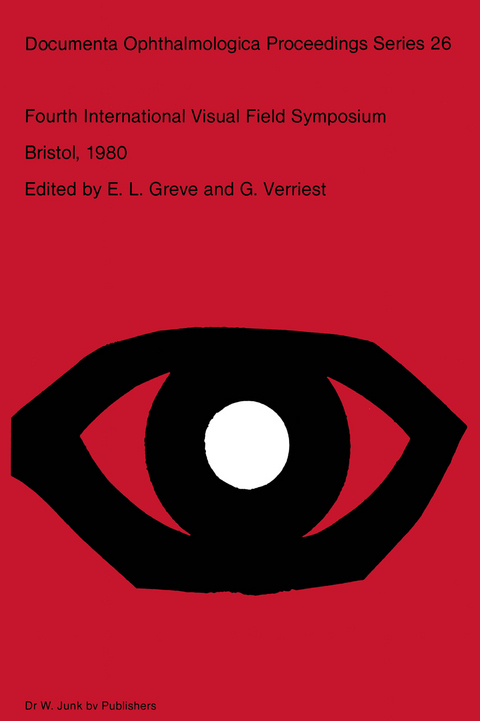
Fourth International Visual Field Symposium Bristol, April 13–16,1980
Springer (Verlag)
978-94-009-8646-6 (ISBN)
one: Computer assisted perimetry.- Automatic perimeter with graphic display.- Statistical program for the analysis of perimetric data.- Changes of glaucomatous field defects. Analysis of OCTOPUS fields with programme Delta.- The peritest.- Detectability of early glaucomatous field defects. A controlled comparison of Goldmann versus Octopus perimetry.- Visual field in diabetic retinopathy (DR).- Detection and definition of scotomata of the central visual field by computer methods.- A clinical comparison of three computerized automatic perimeters in the detection of glaucoma defects.- Capabilities and limitations of automated suprathreshold static perimetry.- Reliability of visual field examination in clinical routine.- two: Psychophysical and visually evoked electrical responses.- Psychophysical and electrophysiological determinants of motion detection.- Perimetry and pattern — VECP in chiasmal lesions.- Visual field (VF) versus Visual evoked cortical potential (VECP) in multiple sclerosis patients.- Quantitative perimetry in optic subatrophy from previous optical neuritis in multiple sclerosis.- Differences in the visual evoked potentials between normals and open-angle glaucomas.- three: Special psychophysical methods.- Patterns of visual field alterations for liminal and supraliminal stimuli in chronic simple glaucoma.- Receptive field-like properties tested with critical flicker fusion frequency. Perimetrie analysis.- Flicker fusion in pericoecal area.- Acuity perimetry.- Visual field studies with fundus photo-perimeter in postchiasmatic lesions.- Flicker fusion and spatial summation.- The Aulhorn-extinction phenomenon. Suppression scotomas in normal and strabismic subjects.- Spatial summation in the foveal and parafoveal region.- Comparison of spatial contrastsensitivity with visual field in optic neuropathy and glaucoma.- Richard-Cross-Lecture.,Early disturbances of colour vision in chronic open angle glaucoma.- four: Colour perimetry.- Is clinical colour perimetry useful?.- Extrafoveal stiles’ ?5-mechanism.- An instrument for the establishment of chromatic perimetry norms.- Fully-photopic and -scotopic spatial summation in chromatic perimetry.- A comparison between white light and blue light on about 70 eyes of patients with early glaucoma using the Mark II Visual Field Analyser.- An attempt of flicker perimetry using coloured light in simple glaucoma.- Subclassifications of retinitis pigmentosa from two-colour scotopic static perimetry.- A report on colour normals on the Friedmann Mark II Analyser.- five: Instruments and strategies.- The sine-bell screener.- The sine-bell stimulus in perimetry.- Central field screener. A new tool for screening and quantitative campimetry.- A new screening method for the detection of glaucomatous field changes. The flicker triple circle method.- Prototype campimeter AS-2 and its applicability with both eyes open.- An evaluation of the Friedmann analyser Mark II.- six: Optic nerve.- Optic nerve function in the toxic amblyopias and related conditions.- Fundus controlled perimetry in optic neuropathy.- The pericoecal area in optic sub-atrophy.- Kinetic perimetry (in the plateau region of the field) as a sensitive indicator of visual fatigue or saturation-like defects in retrobulbar anomalies.- Static and acuity profile perimetry in optic neuritis.- Visual field loss and pupillary dysfunction (abstract).- Hereditary dominant optic atrophy.- seven: Visual field defects in various diseases.- Residual field changes in patients with idiopathic central serous retinopathy.- Visual field defectcharacteristics in cases of hyperprolactinaemia.- Correlation between the stereographic shape of the disc excavation and the visual field of glaucomatous eyes.- The frequency distribution of early visual field defects in glaucoma.- Visual field investigation in cerebrovascular accident.- Refraction scotomata and absolute peripheral sensitivity.- eight: Varia.- Screening of visual field defect among healthy adults. A preliminary trial of population survey of ocular disease.- Grids for functional scoring of visual fields.- A procedure for the computer coding of visual fields.- Relationship between fundus densitometric analysis and perimetry.- The normal pericoecal area. A static method for investigation.- Authors index.
| Reihe/Serie | Documenta Ophthalmologica Proceedings Series ; 26 |
|---|---|
| Zusatzinfo | 416 p. |
| Verlagsort | Dordrecht |
| Sprache | englisch |
| Maße | 152 x 229 mm |
| Themenwelt | Medizin / Pharmazie ► Medizinische Fachgebiete ► Augenheilkunde |
| ISBN-10 | 94-009-8646-7 / 9400986467 |
| ISBN-13 | 978-94-009-8646-6 / 9789400986466 |
| Zustand | Neuware |
| Haben Sie eine Frage zum Produkt? |
aus dem Bereich


